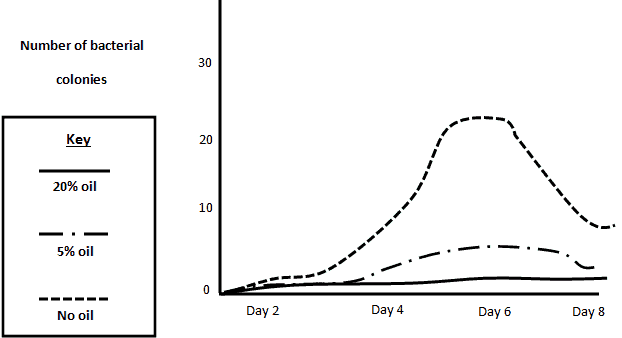UPCAT Science Practice Test

Directions: This Science subtest will gauge your proficiency in basic scientific concepts you learned in high school. Choose the letter that corresponds to your answer.
1. Boyle’s law states that “If the temperature remains constant, the volume of a gas varies inversely as the pressure.” The volume of the gas is 204 mL at 840 mm pressure. Calculate the volume of the same gas at 765 mm if the temperature is held constant.
A. 112 mL
B. 224 mL
C. 288 mL
D. 336 mL
2. A student holds a hand mirror to observe the back of her head while standing in front of and looking into a wall mirror. If she is standing 4 feet in front of the wall-mirror and she holds the hand-mirror 1 foot behind her head, she will see the back of her head how far behind the wall-mirror?
A. 6 feet
B. 5 feet
C. 4 feet
D. 3 feet
3. The Law of Superposition states that in undisturbed strata of sedimentary rock, the oldest rock layer is at the bottom, the youngest at the top. If geologists can determine which way was originally “up” in a stack of layers, they can put those strata in the correct historical order. Rarely, after a sequence of layers has been deposited and compressed to form rock, it may be literally overturned by the thrusting of the Earth’s crust as continental plates collide. In rare cases like this, how can the original sequence of the rocks be determined?
A. Collect samples in near-by undisrupted areas.
B. They cannot be determined.
C. Carbon-date the fossils that are formed within the sedimentary rock layers
D. They are totally in the reverse order of oldest to youngest
4. The magnetic needle of a compass always points to the north because
A. the needle touches the north pole.
B. the earth has a magnetic north pole.
C. compasses are used for finding direction.
D. the earth’s magnetic field is strongest at the south pole.
5. The translational speed of the center of mass of a bowling ball that rolls without slipping along the horizontal section of the ball return is 3.50 m/s. It then moves through a vertical rise of 0.760 m on the way back to the ball rack. If you neglect frictional losses and assume that the mass of the ball is distributed uniformly, then what is the translational speed of the ball at the top of the rise?
A. 1.27 m/s
B. 1.52 m/s
C. 1.52 m/s
D. 4.78 m/s
6. Water is essential in the process of photosynthesis. In plants, water is first absorbed in the roots and is conducted all the way to the leaves where photosynthesis primarily occurs. This conduction process occurs through the xylem vessels of plants.
There are two forces that participate in this water conduction: adhesion and cohesion. Adhesion refers to the attractive forces between the water molecules and the walls of the xylem vessels, while cohesion refers to the attractive forces among water molecules. Suppose an air bubble is present in a xylem vessel, the conduction of water will be unable to proceed. What is the reason behind this phenomenon?
A. The air bubble interrupts the cohesive forces among the water molecules. It cuts the continuous stream of water, making it unable to continually flow.
B. The air bubble interrupts the adhesive forces between the walls of the xylem vessels and the water molecules.
C. The air bubble is less dense than water, therefore impeding the continuous flow of water.
D. The air bubble creates a pocket of space that eventually kills the xylem cells, thus preventing it from resuming water conduction.
7. Which one of these is not true?
A. All planets revolve in the same direction.
B. All planets rotate in the same direction.
C. The orbits of the planets are all ellipses.
D. The orbits of the planets are nearly in the same plane.
8. A new vaccine was discovered as a treatment for a certain viral chicken disease. What should a scientist do in order to test for the effectivity of the vaccine?
A. Administer the vaccine to 50 chickens and expose all of them to the disease.
B. Administer the vaccine to 25 of 50 chickens and expose all 50 chickens to the disease.
C. Expose 25 of 50 chickens to the disease then vaccinate all 50 chickens.
D. Expose all 50 chickens to the disease then vaccinate 25 of them.
9. As the drops of water that leak from a dripping faucet fall, they
A. get closer together.
B. get farther apart.
C. the pattern of their motion can’t be determined.
D. remain at a relatively fixed distance from one another.
10. An astronaut orbits the earth in a space capsule whose height above the earth is equal to the earth’s radius. How does the weight of the astronaut in the capsule compare to her weight on the earth?
A. Her weight is equal to her weight on earth.
B. Her weight is equal to one-fourth her weight on earth.
C. Her weight is equal to one-half of her weight on earth.
D. Her weight is equal to one-third of her weight on earth.
Read the passage below to answer question numbers 11 to 16.
A group of scientists were studying the growth of bacteria. It is their hope that they will be able to induce the bacteria to grow and metabolize oil as a food source. They have taken three samples of Escherichia coli and are growing them on nutrient agar plates. The scientists used three conditions to test the E. coli bacteria. The first group was grown at 37°C on plain nutrient agar plates. The second group was grown at 37°C on plain nutrient agar plates with a 5% oil solution. The third group was grown at 37°C on plain nutrient agar plates with a 20% oil solution. The results of the experiment are listed in the graph below.

11. What is the independent variable in the experiment above?
A. The type of bacteria used
B. The nutrient agar.
C. The nutrient agar with oil.
D. The number of days the bacteria grew.
12. What is the dependent variable in the experiment above?
A. The number of days the bacteria grew.
B. The nutrient agar.
C. The nutrient agar with the oil.
D. The amount of growth of the bacteria
13. Which bacterial culture had the greatest rate of growth throughout the 8 day period?
A. Only the culture grown on nutrient agar had significant growth.
B. The nutrient agar plate and the 5% oil plate had growth.
C. The nutrient agar plate and the 20% oil plate had growth.
D. The 5% oil and 20% oil plates had growth.
14. What is the best explanation for why the E.coli grew on the 5% oil plate but not the 20% oil plate?
A. The bacteria are used to an environment with 5% oil and not 20% oil.
B. The bacteria were able to mutate to tolerate a slightly oily environment of 5% oil, providing it had other nutrients available and the 20% had far too much oil.
C. The 5% plate had conditions that are similar to the natural environment they are accustomed to.
D. The 5% plate allowed more oxygen to interface with the bacteria because less oil was present.
15. Why did the nutrient agar bacteria plateau and then drop in numbers as they approached Day 8?
A. The bacteria died because they had reached their mature age.
B. The bacteria ran out of nutrients and had reached the carrying capacity of the plate.
C. The bacteria always die after Day 6 in culture.
D. There is no definitive reason why the bacteria died off after Day 6.
16. An excellent way to demonstrate that the scientists have induced E.coli to survive and metabolize oil would be to:
A. Repeat the experiment several times with 5% oil on a nutrient agar plate.
B. Induce the bacteria on the 5% oil plate to grow on nutrient agar.
C. Take the bacteria from the 5% oil plate and test them on a new 20% oil plate.
D. new bacteria with the same experiment to see if that is the only bacteria that can accomplish this.
17. Why does semen have alkaline bases as part of its composition?
A. To maintain a neutral environment for the sperm to “swim” in.
B. To protect the sperm from the acidic environment in the vagina.
C. To speed up the transport of the sperm to the fallopian tube.
D. To destroy any rival sperm cells inside the vagina.
18. A forensic anthropologist would most likely use which bone to determine the height of a corpse?
A. phalanges
B. femur
C. occipital
D. patella
19. Professor Geller wanted to demonstrate the role of osmosis in plant cells. He placed the cells in a solution that is hypertonic to the cells. The solution contains red microscopic dye particles. Which of the following could be a possible result of Professor Geller’s demonstration?
A. Plant cells decrease in size (flaccid), and the solution will have a lighter color.
B. Plant cells increase in size (turgid), and the solution will remain the same color.
C. Plant cells maintain their size, and the solution will become darker.
D. Plant cells will burst, causing the solution to reduce its color
20. Air cools at the dry adiabatic rate of 10°C for each kilometer it rises. If a parcel of dry air initially at 0°C expands adiabatically while flowing upward alongside a mountain, what is its temperature when it has risen 8 km?
A. – 80°C
B. – 40°C
C. 40°C
D. 80°C
View answer key or go back to UPCAT reviewer main page
Written by FilipiKnow
in Reviewers
FilipiKnow
FilipiKnow strives to ensure each article published on this website is as accurate and reliable as possible. We invite you, our reader, to take part in our mission to provide free, high-quality information for every Juan. If you think this article needs improvement, or if you have suggestions on how we can better achieve our goals, let us know by sending a message to admin at filipiknow dot net
Copyright Notice
All materials contained on this site are protected by the Republic of the Philippines copyright law and may not be reproduced, distributed, transmitted, displayed, published, or broadcast without the prior written permission of filipiknow.net or in the case of third party materials, the owner of that content. You may not alter or remove any trademark, copyright, or other notice from copies of the content. Be warned that we have already reported and helped terminate several websites and YouTube channels for blatantly stealing our content. If you wish to use filipiknow.net content for commercial purposes, such as for content syndication, etc., please contact us at legal(at)filipiknow(dot)net
